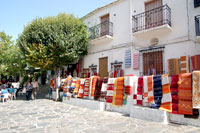Trevélez
From Pampaneira, instead of continuing up to Bubión, you can take the road leading east towards Trevélez. Trevélez lies 75 kilometres from Granada and has a population of 1,150. It is 63 kilometres from the coast at Salobreña and 59 kilometres from the coast at La Rábita. The village has an altitude of 1,476 metres, making it the highest permanent settlement in Spain, and it nestles below the highest mountain in mainland Spain, the Mulhacén. The altitude makes it a cool place, even in high summer, so come prepared.
The local cured hams are some of the finest found anywhere so may sure you try some jamón serrano during your visit. They are dried in the open and exported throughout the world, and may also be eaten in the many bars and restaurants in Trevélez. The village also has plenty of accommodation and a campsite.
Pampaneira, Bubión and Capileira
By taking a left-turn up a hill, just before entering Órgiva, you start the climb up into the high Alpujarra. Passing the pretty hamlets of Carataunas and Soportújar, the first sizable village you will reach is Pampaneira.
 Pampaneira lies in the Poqueira Ravine, 63 kilometres from Granada, 14 kilometres from Órgiva and 50 kilometres from the coast at Salobreña. This is a lush and abundant area with the River Poqueira running over waterfalls below. The village has an altitude of 1,200 metres and a population of 1,000.
Pampaneira lies in the Poqueira Ravine, 63 kilometres from Granada, 14 kilometres from Órgiva and 50 kilometres from the coast at Salobreña. This is a lush and abundant area with the River Poqueira running over waterfalls below. The village has an altitude of 1,200 metres and a population of 1,000.
Over the years, Pampaneira has won many awards for most attractive and best kept village. The streets are narrow and twisting and decorated with a profusion of flowers and fountains. The village has a tourist office, a 16th century Baroque church, good hotel capacity, restaurants, bars and shops selling local crafts.
Carrying on up from Pampaneira you will reach Bubión, 67 kilometres from Granada and 54 kilometres from the coast. It has an altitude of 1,300 metres and a population of 600. The village name is derived from the Latin for Land of Oxen. The village dates back to Roman times but is perhaps more famous for its Moorish origins. The houses are characterised by flat roofs and prominent chimney pots. They spill down the steep mountainside, connected by little walkways and by just one, narrow, winding, cobbled street. The village church is 16th century and stands next to the remains of a Nazrid Arab fortified tower.
The village has hotels, bars, restaurants, workshops producing crafts and precious metalwork and galleries displaying the work of resident artists. There is also a rural hotel complex situated outside of the village, close to the no longer standing village of Alguastar, known as the Poqueira Tourist Complex. Run by a cooperative, the complex is a centre for hiking, horseriding and jeep tours.
Continue further up the road and you will reach Capileira, which lies at the top of the Poqueira Ravine facing the Veleta mountain peak. The village is 71 kilometres from Granada by 'main' road and 58 kilometres from the coast. It has an altitude of 1,436 metres and a population of 900.
Within the village, there are hotels, bars, restaurants and artisan workshops. The narrow streets open into various squares one of which, the Plaza de Calvario, houses a culture centre which is also a museum and residence for artists. The culture centre is named after Pedro Antonio de Alarcón, a renowned traveller from Guadix. The lower part of the village stands over the Tajo del Diablo (Devil's Gorge) from where there are wonderful sweeping views.
From here there is a road over the mountains that leads to the Sierra Nevada ski-station but this route is now closed to traffic.





